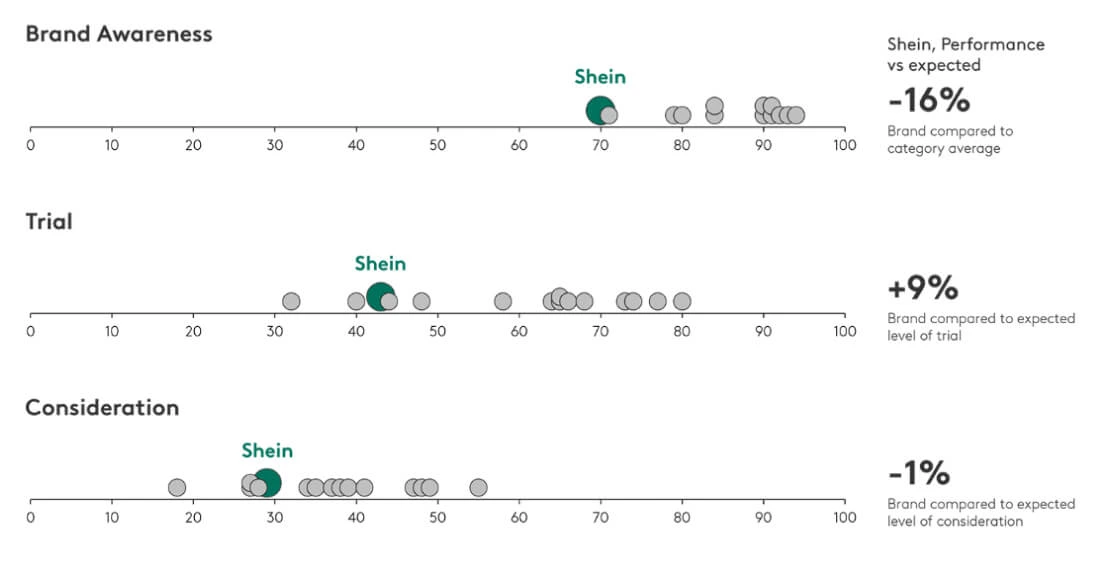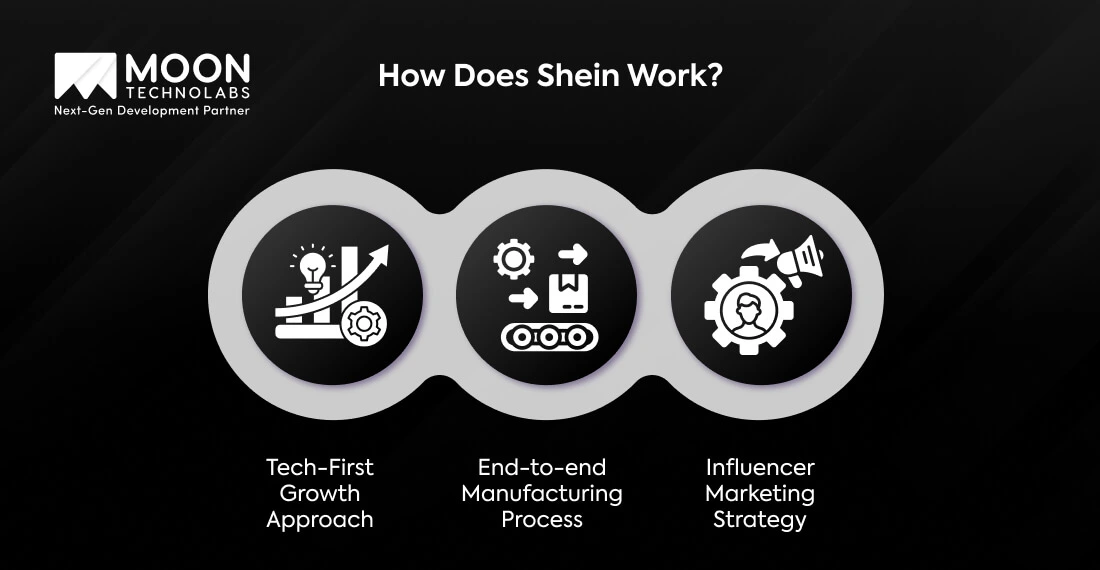Table of Content
Blog Summary:
To build a fast-fashion platform like Shein, businesses should integrate AI-powered trend forecasting, real-time inventory systems, and mobile-first experiences. This blog explores the must-have elements and strategy for creating a high-performance, fashion-forward eCommerce platform that ranks, engages, and grows.
Table of Content
In under a decade, Shein went from obscurity to disrupting the fast-fashion world without owning a single store. Most fashion brands struggle with inventory, speed, and margins. However, Shein brought many lessons that other similar businesses and startups can learn from its USD 100 billion business model.
So, how did Shein solve these at scale?
The Shein Business Model leverages real-time data, agile supply chains, and influencer-first marketing to outpace traditional retailers. It made its first leap during the COVID-19 pandemic, jumping from USD 2.5 billion in 2019 to USD 8.4 billion in 2020.

As of the first 15 weeks of 2025, it had 42.6 million app downloads and reached USD 54.4 billion in net sales!
This blog dives into Shein’s strategic core, explaining how it scales production in days, connects directly with young consumers, and uses technology to stay ahead of fashion curves.
If you’re building or scaling a DTC brand, Shein offers a masterclass in operational speed, digital branding, and customer obsession. Let’s break it down.
Shein started its journey in Nanjing, China. Today, it’s a household name across over 220 locations worldwide, capturing the hearts (and wallets!) of Gen Z and millennials.
Founded in 2008 by Chris Xu, it has established itself as a leading global online fast-fashion retail platform in the direct-to-consumer (D2C) market.
Before proceeding, take a look at how “fast” the fast-fashion industry has grown from USD 141.23 billion in 2024 to USD 163.21 billion in 2025. As predicted by Research and Markets, this annual growth rate of 15.6% will increase further by 7% by 2029, reaching USD 214.24 billion.

With a catalog of 600,000+ products, it offers men’s and women’s apparel, children’s wear, and other fashionable products such as shoes and bags. However, Shein’s product mix is quite diverse. In fact, the story behind its journey of success never started as a fashion retailer.
Today, even though it also sells furniture, care products, and electronics, it initially focused on selling affordable bridal dresses and gowns to overseas customers.
Chris launched a company called ZZKKO and rebranded it as SheInside, broadening the product range beyond bridalwear. By 2015, it became Shein, expanding it to trend-forward, everyday fashion at unbeatable prices and lightning-fast delivery.

In 2021, Shein became the most downloaded shopping app in the U.S., surpassing Amazon at its peak. Bloomberg Second Measure reported that its market share rose from 18% to 40% from 2020 to 2022. As 2023 started, Shein bagged the first rank in global iOS shopping apps.
Here’s a breakdown of the key features that you can introduce while building an e-commerce app like Shein:
Shein uses AI and big data analytics to monitor fashion trends constantly from:
Shein operates a hyper-responsive supply chain anchored by:
Shein’s products are priced significantly lower than most competitors, but are designed to look stylish and trendy.
Shein keeps users hooked and engaged through:
Though based in China, Shein has developed a global logistics network, including:
We’ll map out your go-to-market personalized blueprint in 30 minutes using AI and real-time data for lightning-fast decisions!

While its e-commerce platform is the primary channel for sales, what makes this business model interesting is that the online infrastructure is connected with factories, which continuously receive real-time data.
By understanding what’s working and what’s not, the data gathered helps understand the user demand through signals and helps Shein in building products that customers want.

Shein’s success is highly dependent on its tech-first approach to the real-time production feedback loop. It integrates AI and big data analytics to forecast trends and test micro-batches.
These batches are usually the SKUs produced in 100 – 200 units, from which the company scales only those that are the most promising designs.
This helps them reduce risk and waste while also enabling them to launch thousands of new styles daily with remarkable agility. By monitoring browsing behavior, search patterns, and social signals, Shein aims to design and release new products in just 3–7 days rather than forecasting in advance.
Similarly, Shein’s influencer marketing strategy allows it to generate massive user-generated content (UGC), helping Shein stay hyper-relevant across Gen Z audiences. Its decentralized model partners with micro-influencers on TikTok, Instagram, and YouTube to fuel daily engagement through hauls, challenges, and creator content.
Shein earns most of its revenue from direct product sales through its e-commerce platform. While offering low-cost fashion items such as clothing, accessories, shoes, and beauty products, it also aims to target price-sensitive Gen Z and Millennial consumers globally.

Its key model is fast fashion, which builds on a rapid design-to-sale cycle. Shein is primarily focused on selling in-house manufactured and white-labeled products under its own brand. This private label strategy ensures Shein earns higher profit margins without any middlemen or brand licensing costs.
Shein curates and manages the entire product lifecycle for better brand control. Collections are exclusive to the platform, encouraging brand loyalty.
Additionally, Shein collaborates with influencers and designers on limited-edition drops and exclusive collections to generate buzz and scarcity-driven demand.
The Shein app plays a key role in monetization through push notifications and personalized promotions. It uses numerous gamified features, like daily check-ins and point rewards. To increase app conversions, it uses data-driven upselling and cross-selling, implementing AI recommendations based on user behavior.
Check out how we developed a highly user-friendly grocery app – InstaGroc, with AI recommendations for one of our clients.
The app serves as a retention engine and sales funnel, reducing CAC (Customer Acquisition Cost) and boosting LTV (Lifetime Value). Shein is continually expanding to grow its customer base and revenue through new geographical locations.
Partner with us to build your own fashion commerce engine and build a clear path to a responsive inventory system.
Shein has faced significant backlash over its labor practices, which have caused damage to its brand image. Ethically conscious consumers and eco-conscious consumers have also led to risks of legal penalties or boycotts.
Here are some of the others:
Shein has faced allegations of poor working conditions, underpaid labor, and long working hours in supplier factories. It also has concerns related to a lack of transparency in its supply chain audits and factory compliance with international labor laws.
As a fast-fashion brand, Shein’s business model is inherently waste-intensive and unsustainable. Its products are frequently dropped, and mass production generally relies on cheap synthetic materials that are harmful to the environment.
Shein faces tough competition from Zara, H&M, and Uniqlo, which are investing in digital transformation and sustainable fashion lines. Many emerging D2C platforms and marketplaces, like Temu and AliExpress, are also adapting to faster deliveries.
Operating globally, Shein also has to navigate through import and export regulations, customs duties, and tariffs in dozens of countries. Moreover, it’s also under tax scrutiny with rising criticism of cross-border e-commerce loopholes.
Launch a custom e-commerce platform with us, tailored to fast fashion businesses aiming to replicate Shein’s success. By integrating AI and ML, we enable real-time trend forecasting and personalized recommendations to drive conversions.
Our scalable cloud-based infrastructure ensures smooth performance during high-traffic flash sales and product drops. We develop intelligent inventory and logistics management solutions to support agile supply chains and optimize fulfillment.
With a focus on fashion retail, our e-commerce app development services include gamified experiences, push notifications, and AI-powered styling suggestions to boost user engagement.
As your end-to-end tech partner, we at Moon Technolabs don’t just build apps; we enable you to thrive with performance, style, and innovation at scale.
Building a successful fast-fashion platform today requires more than just a product catalog—it demands a deeply engaging shopping experience. With AI-driven design predictions, agile logistics, mobile-first user journeys, and gamified experiences, businesses can tap into a high-growth model similar to Shein’s.
Whether you’re entering the market or scaling an existing brand, a smart blend of technology, customer insight, and operational agility is key to thriving in the global fashion e-commerce landscape.
Let’s collaborate and turn your fashion vision into a high-performing, trend-responsive fashion commerce platform that attracts, retains, and converts.
01
02
03
04
05
Submitting the form below will ensure a prompt response from us.